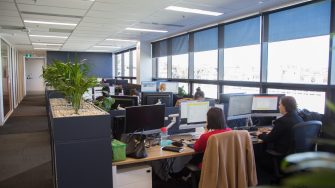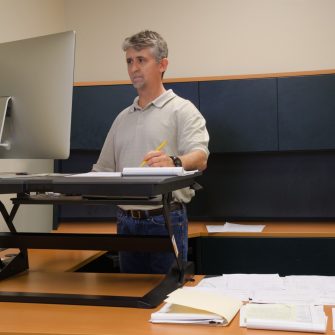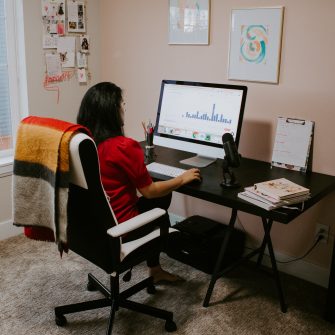
Prolonged work at a desk or computer and/or poor workstation setup are hazards that in some circumstances, can aggravate or lead to work-related injuries or diseases, particularly of the neck, back and upper limbs.
The risk of overload of musculoskeletal structures associated with workstation use can be effectively managed by setting up your workstation correctly, maintaining a neutral posture and ensuring that you alternate positions periodically.
-
UNSW’s self-management strategies are designed to provide workers with the capability to identify, understand and manage risks related to the use of workstations in an efficient and effective manner. This enables workers to pro-actively manage related risks wherever they are working, including when they move workstations or work from other locations other than their usual on-campus setting.
Several tools are available to provide workers with the capability to adjust their workstation, posture, and work practices. All workers are required to:
- Complete the online Ergonomics and Manual Tasks Training (mandatory and a requirement of staff induction).
- Complete the HS114 Workstation Checklist, opens in a new window (mandatory and a requirement of induction), including making appropriate adjustments. Using a buddy to assist with this may be helpful.
- If you have an arrangement to work from home, ensure that you also complete the Working from Home Checklist in SALUS. For guidance on how to complete the checklist, please read this Guide, opens in a new window.
- Take appropriate rest breaks and change position periodically. Regular rest breaks will assist to relieve muscle fatigue and eyestrain; assist in preventing injuries and assist in restoring concentration levels. Get Up and Move! provides tips on how to make the most of your rest breaks by adding movement into your workday.
Managers are responsible for ensuring workers within their area of responsibility complete the above controls.
-
Non-work-related health conditions
Workers experiencing problems related to a disability should discuss with their manager and refer to the Reasonable Adjustment, opens in a new window information. See also Funding for Workers with Disabilities or Special Needs.
Work-related health conditions
If a worker is experiencing physical symptoms that are work-related, escalating and/or not alleviated by the completion of the measures above, they should discuss with their manager and:
Report and investigate the incident. If an individual has sustained an injury or illness that was caused or substantially aggravated by work activities at UNSW, they should complete an incident report in myUNSW. This will help to understand what problems the person is currently experiencing, how this is impacting on them and how to solve the problem. The responsible person (usually the worker’s manager) should investigate the incident in consultation with the worker to understand and identify the contributory factors (which may be related to posture, workstation set up and/or work practices) and related actions to resolve the problem. The corrective actions should be recorded in myUNSW and tracked to completion. Managers should monitor appropriately to ensure that the problem has resolved.
Further assistance. Allow a reasonable period for the adjustments from the self-management strategies above to take effect. If an individual is still experiencing problems after this time, please escalate to your WHS Business Partner or Coordinator. At this time, the evidence is to be provided that appropriate measures have been taken to resolve the problem, including completion of the above self-management strategies.
Note: the cost of further intervention or equipment is covered by the Business Unit.
Related documents
Checklist
Procedure
Form




